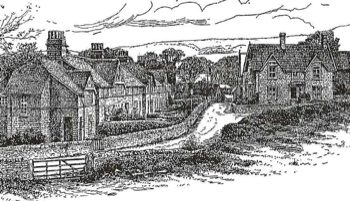THE place where Lydia Trivett worked and controlled the activities of twenty other women was a lofty, raftered hall lighted from the north by a row of windows under which the sorters sat. In the midst of the chamber the material was piled in huge, square bales covered with sacking. The parcels came from all parts of Europe, where linen and cotton rag could be obtained; and before they were handled, the contents entered a thresher for preliminary dusting. The thresher throbbed and thundered within a compartment boarded off from the workshop. Here in a great wooden case, a roller with iron-shod teeth revolved, while above this lower, moving wheel, fixed prongs stood similarly armed, so that their teeth passed between each other at every turn. Here spun the rags and whirled and tossed, while the dust of France, Belgium, England, Ireland, Scotland was sucked away from them.
Every rag that entered Dene Mill was subjected to this rough initial embrace, where Alice Barefoot, a tall, strong woman, attended the thresher. She was herself of the colour of dust, with a high complexion and lion-coloured hair, tied up in a yellow kerchief. She prided herself on doing man's work and, indeed, accomplished her heavy labours very completely. The dusted rag she piled in tall baskets, stopped the thresher, then opened the door of the chamber and bore the rag out to the sorters. They sat each before her lattice with the material heaped at her left. The practised workers dealt very swiftly with the stuff, running it between their hands and knowing its composition by touch. Wool or silk sometimes intruded, but was flung aside, for only cotton passed to the empty baskets at each woman's right. The workers were clad in white overalls and their heads were covered with white caps and bonnets. Wonderful cleanliness marked them and the atmosphere of the brightly lighted shop was clear despite the flocculent material that passed through it.
For purity of air and water, chemicals and working hands is a vital matter to the paper maker. Every operation must needs be as cleanly as sleepless precaution can make it.
From the mountain of rags on her left the sorter plucked material and picked it over the lattice, an open wire-work sieve spread before her. Standing beside it was a short upright knife used to cut the rags and sever from them the buttons, hooks and eyes, whalebones and other extraneous additions that had belonged to their earlier incarnations.
These knives were made from old steel scythes worn too thin for husbandry, but here answering a final purpose of value. The hones hummed from time to time, for the busy knives needed constant sharpening. Their cutting edge turned away from the workwoman and to it she brought the material fragments of every garment ever manufactured from spun cotton.
The history of many a single rag had been a feminine epic, from its plucking in a far off cotton field to its creation, use, adventures, triumphs, tragedies and final dissolution. Here they were from the dust heaps of a continent, from the embracing of bodies noble and simple, high and low, young and old, sweet and foul.
Reference: The Story of Handmade Paper (1924)

Wookey Hole Village, Somerset
Their tags and buttons were swiftly cut away and each grille exhibited a strange assortment of trophies pearl and glass, metal and foil, whalebone and indiarubber. Even so many foreign substances escaped the sorters, to be captured at a later period in the purification of the rag.
The women sat back to back and there was little speech among them. Their hands twinkled in a sort of rhythmic measure from right to left and left to right. Then, as their baskets were filled, came Alice Barefoot to carry them away and pile fresh accumulations from the thresher.
To-day the work was old rag; but sometimes a consignment of fragments and overplus from the collar and shirt factories arrived clean and white. Out of them had garments been cut and the remnants needed nothing but shortening and dismemberment upon the knives and picking over for coloured threads, or rubbish that hang about them.
Here reigned Lydia and herself worked at a lattice with the rest. She had only come to the Mill when her husband died; but her skill proved great and her influence greater. Blind-folded she could have done her sorting and separated by touch the cotton, or linen, from any other textile fabric. She was clad in a big white garment and had wrapped her head and neck in a pale blue handkerchief so that her face only appeared.